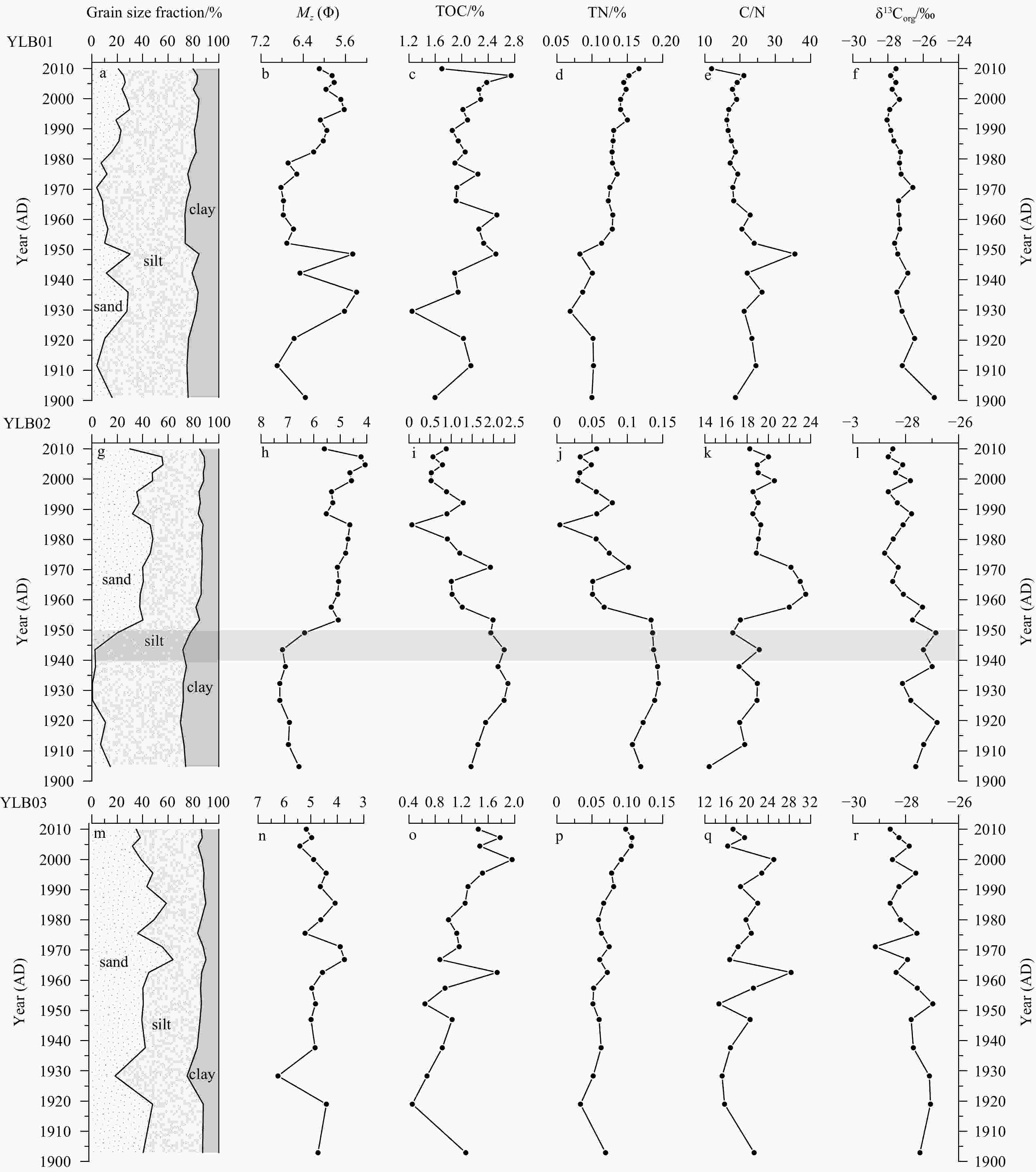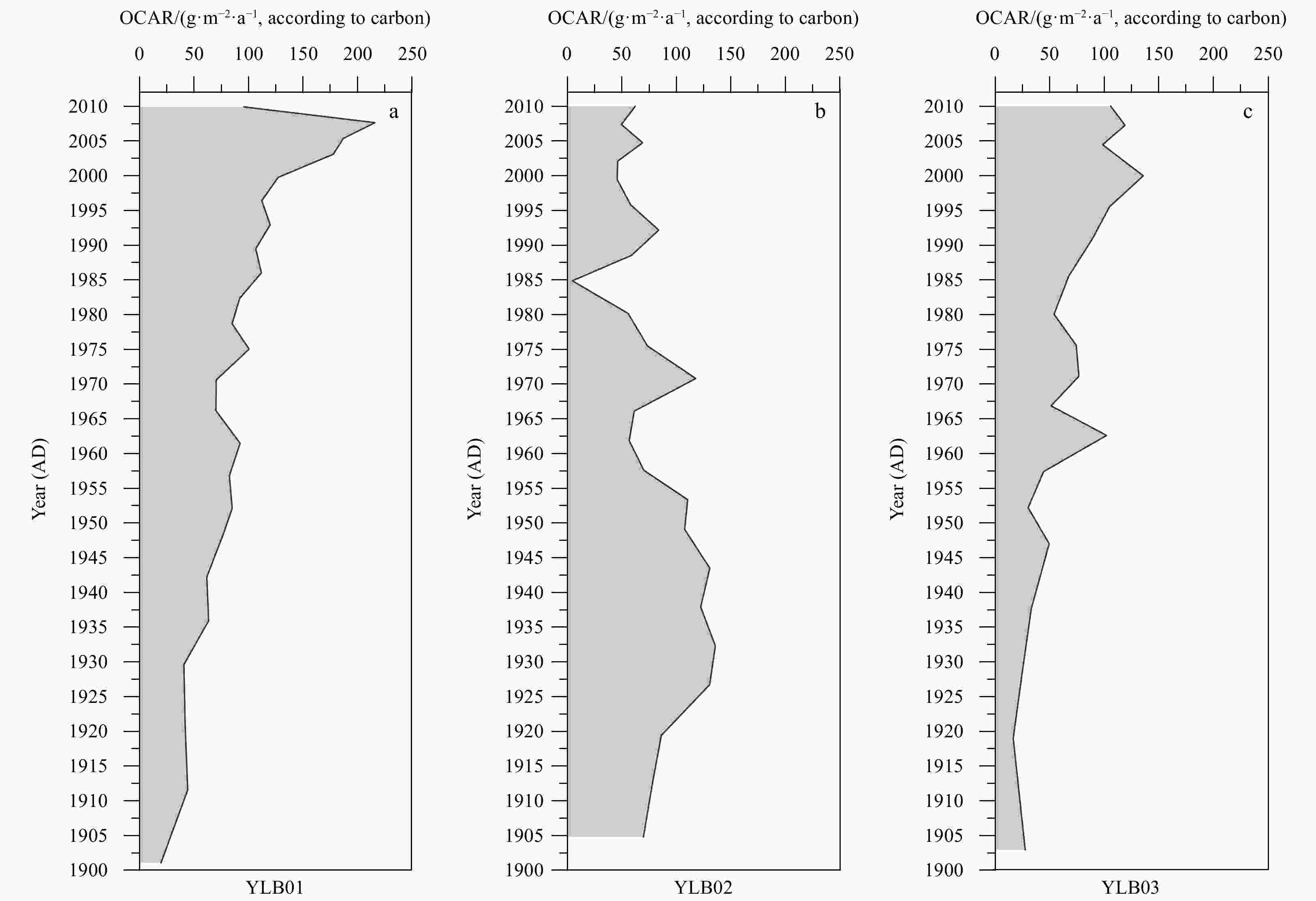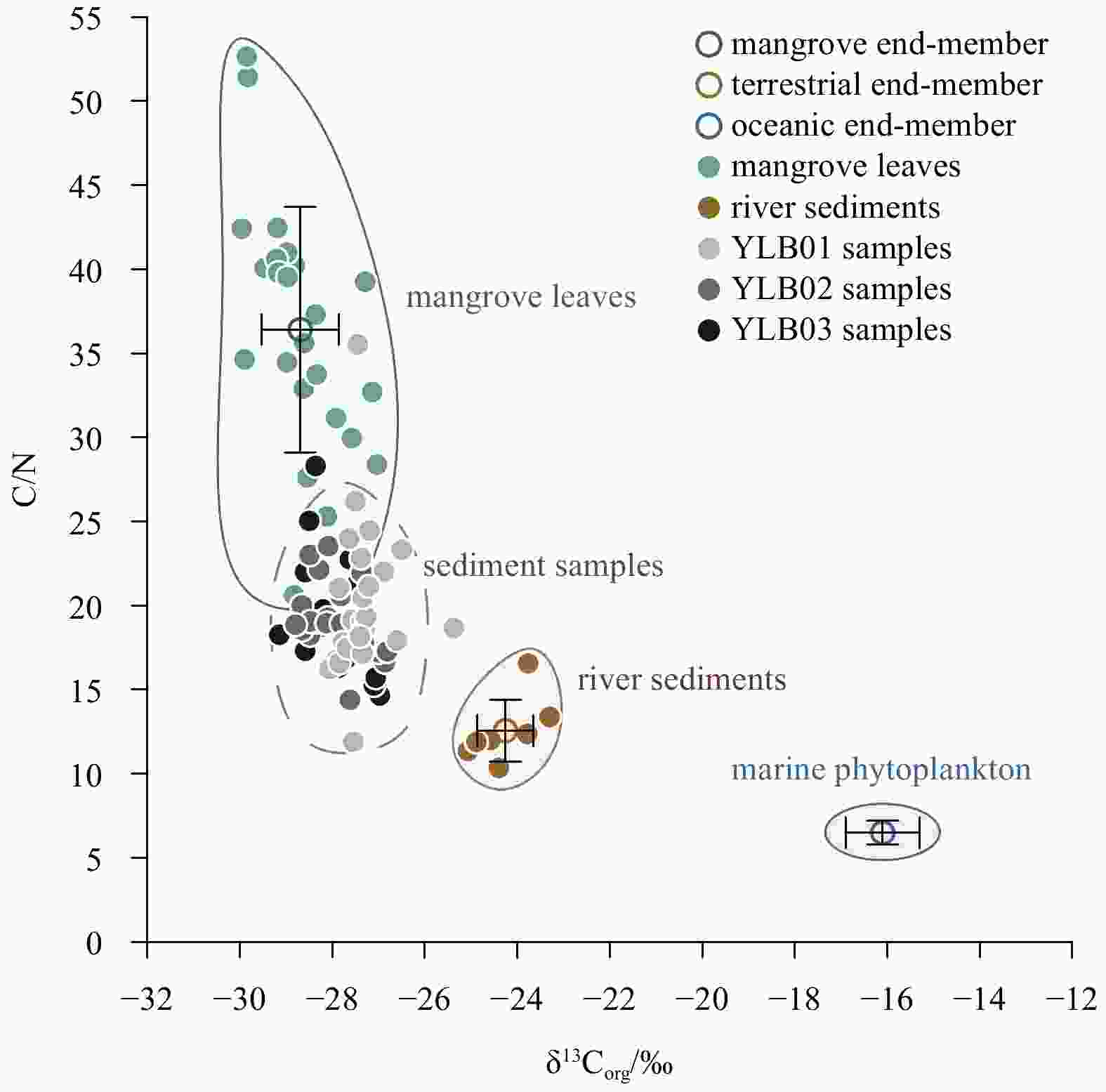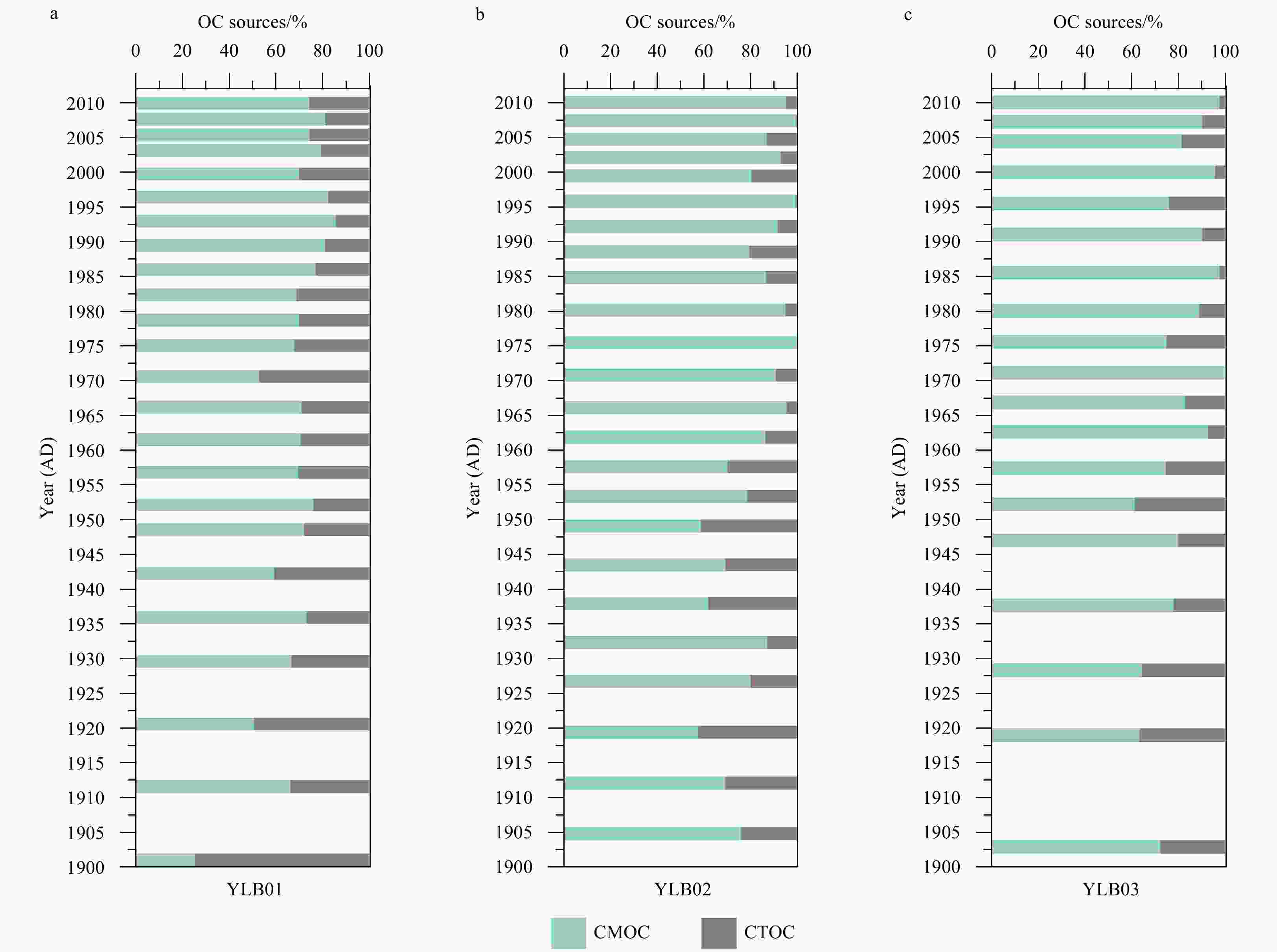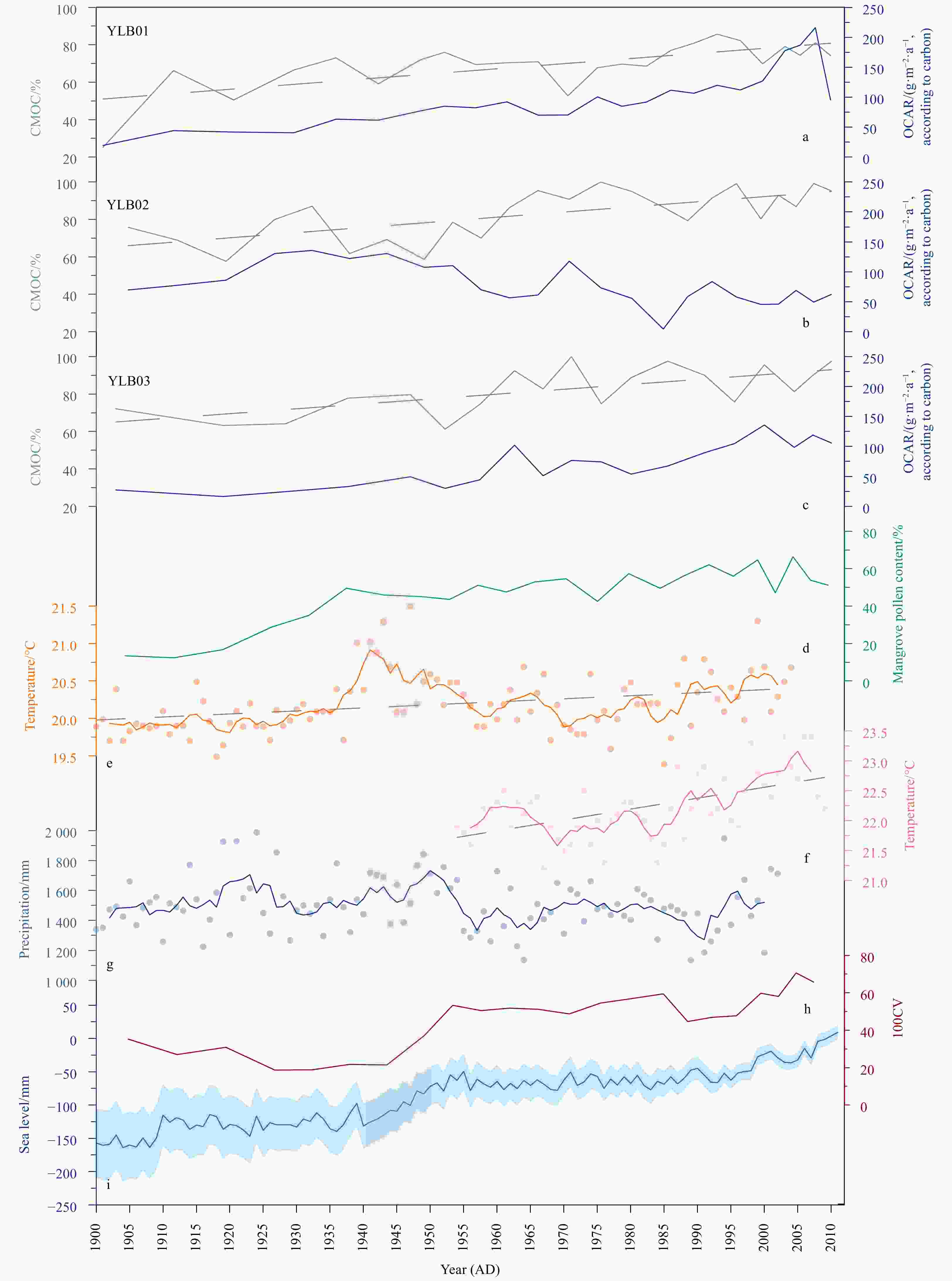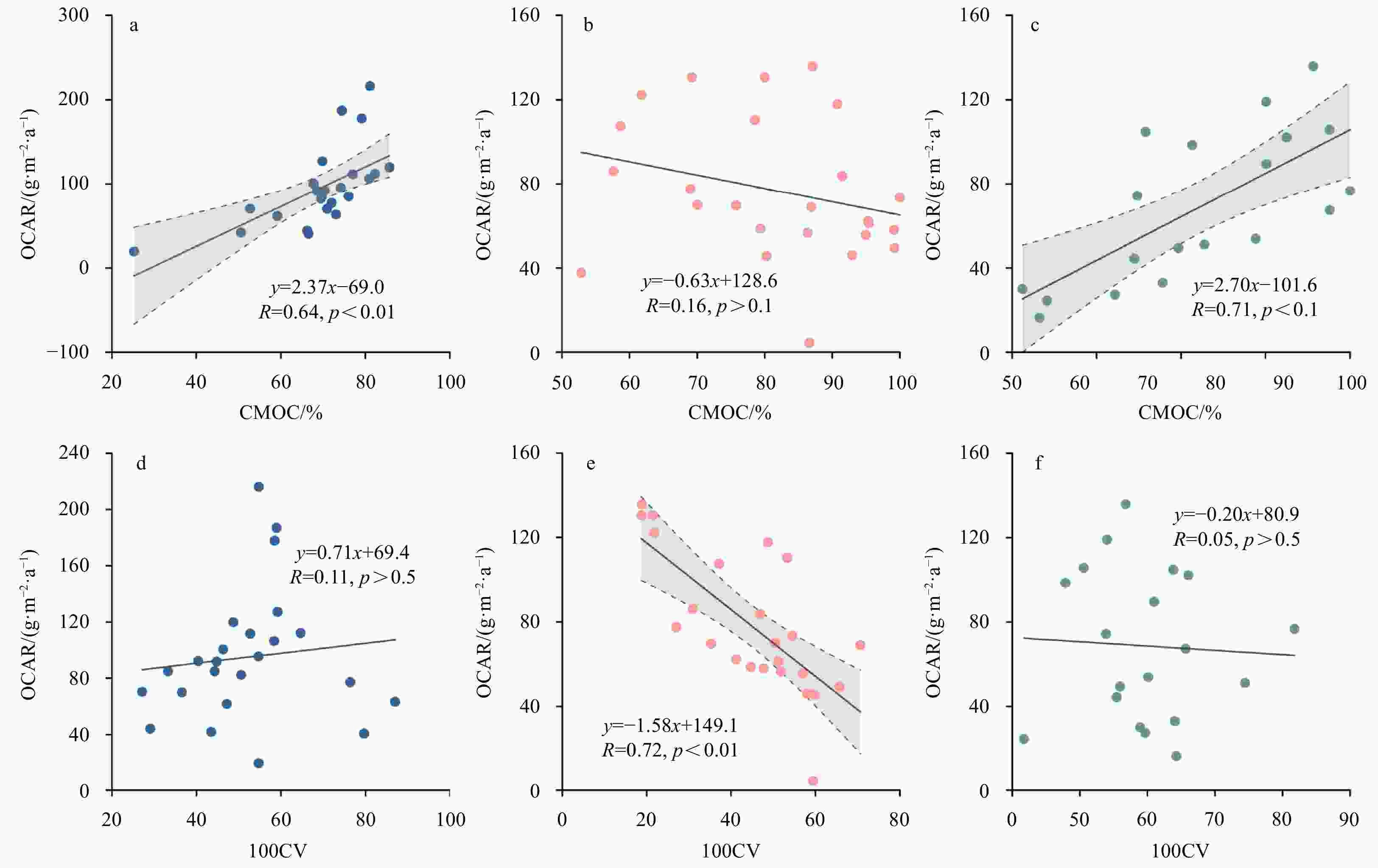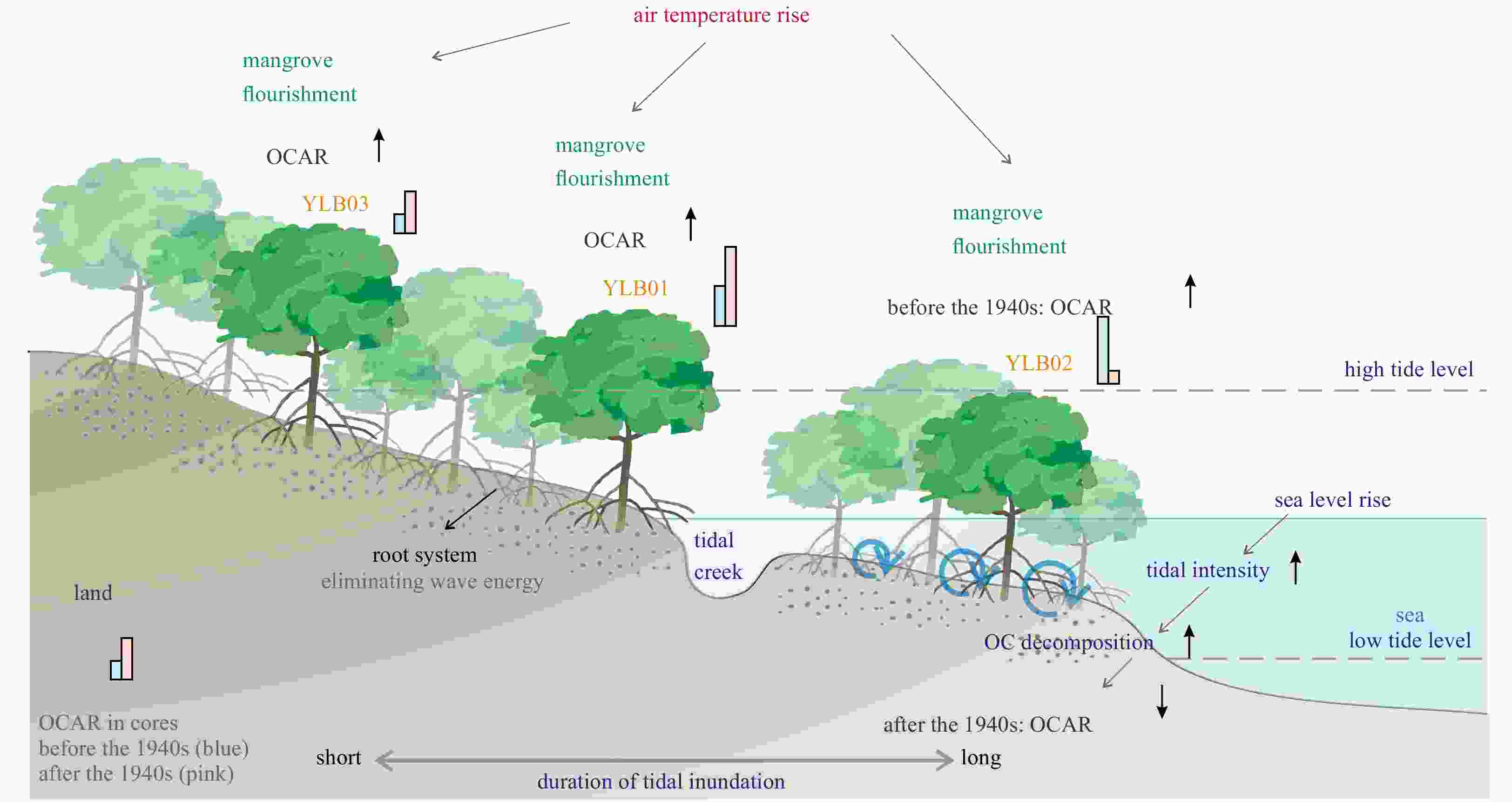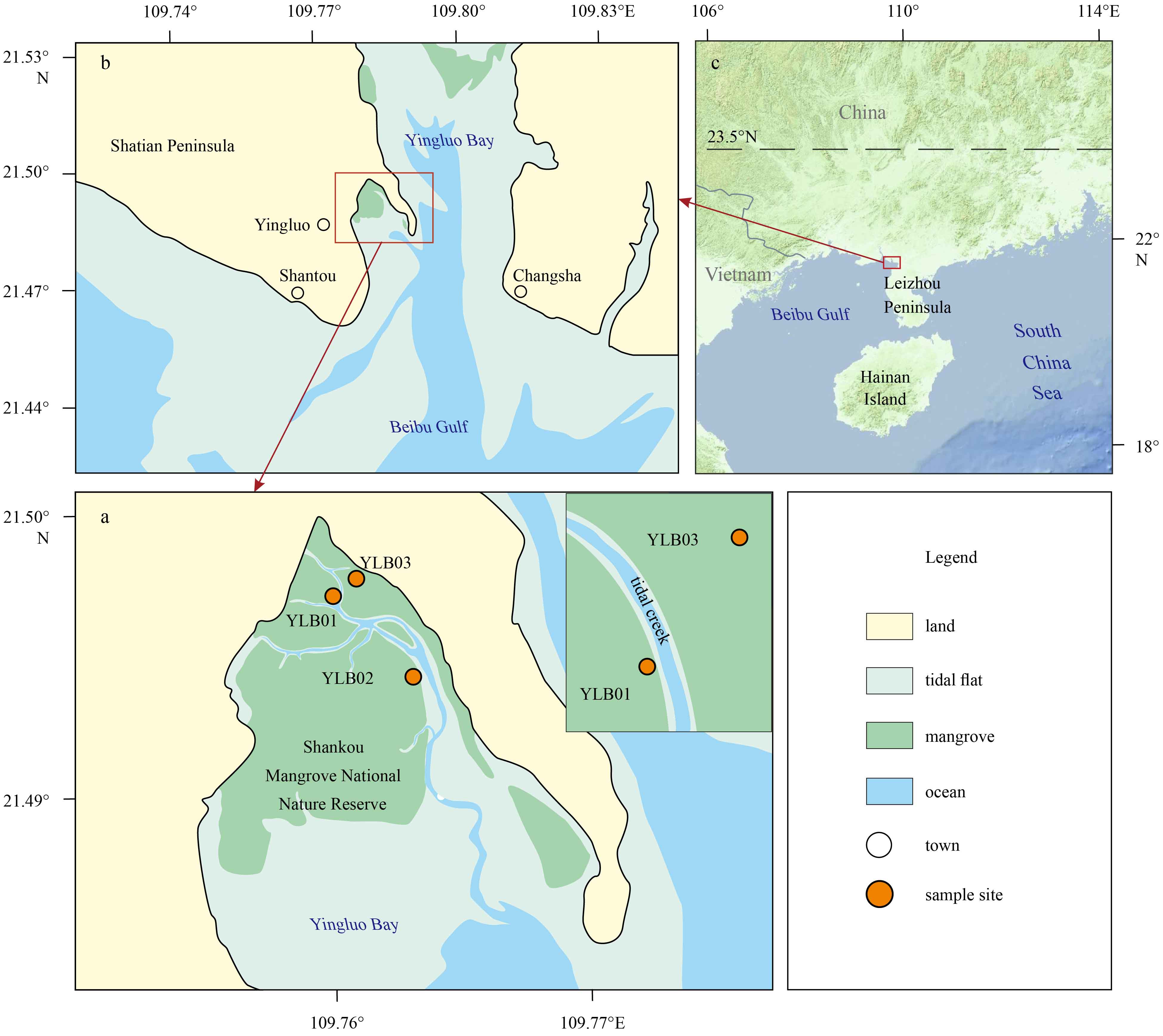Spatiotemporal variations in the organic carbon accumulation rate in mangrove sediments from the Yingluo Bay, China, since 1900
-
Abstract: Mangroves can not only provide multiple ecosystem service functions, but are also efficient carbon producers, capturers, and sinks. The estimation of the organic carbon accumulation rate (OCAR) in mangrove sediments is fundamental for elucidating the role of mangroves in the global carbon budget. In particular, understanding the past changes in the OCAR in mangrove sediments is vital for predicting the future role of mangroves in the rapidly changing environment. In this study, three dated sediment cores from interior and fringe of mangroves in the Yingluo Bay, China, were used to reconstruct the spatiotemporal variations of the calculated OCAR since 1900 in this area. The increasing OCAR in the mangrove interior was attributed to mangrove flourishment induced by climate change characterized by the rising temperature. However, in the mangrove fringe, the strengthening hydrodynamic conditions under the sea level rise were responsible for the decreasing OCAR, particularly after the 1940s. Furthermore, the duration of inundation by seawater was the primary factors controlling the spatial variability of the OCAR from the mangrove fringe to interior, while the strengthened hydrodynamic conditions after the 1940s broke this original pattern.
-
Figure 5. Scatter diagram of δ13Corg vs. C/N for identifying the organic carbon sources in the three sediment cores. The endmember values are from Xue et al. (2009), Xia et al. (2015), and Meng et al. (2016).
Figure 7. Variations and comparison of the organic carbon accumulation rate (OCAR) and contribution of mangrove derived organic carbon (CMOC) in the sediment cores (a–c), mangrove pollen content (Xia et al., 2015) (d), annual average air temperature and average rainfall of Guangxi (e and g) and average air temperature of Beihai City (f) (Huang et al., 2007), coefficient of grain size variation (100CV) of mangrove fringe (YLB02) (h), and sea level changes in the study region (i) (Frederikse, et al., 2020) since 1900. The blue shaded area represents the range of sea-level change. The solid lines in e, f, and g represent the 5 a moving averages of the original data sets. The grey dashed lines are linear regression of the corresponding data sets.
Figure 8. Bivariate plots of the organic carbon accumulation rate (OCAR) vs. the contribution of mangrove-derived organic carbon (CMOC) and coefficient of grain size variation (100CV) in sediment cores of YLB01 (a and d), YLB02 (b and e), and YLB03 (c and f). The dashed lines and shaded areas represent the 95% confidence intervals.
Table 1. Basic information of mangrove sediment cores in the Yingluo Bay, tropical China
Site Latitude Longitude Length
/cmPosition in
mangroveGeomorphic setting Mangrove species YLB01 21°29′49″N 109°45′36″E 66 interior upper tidal flat near the tidal creek Rhizophora stylosa,
Kandelia candelYLB02 21°29′39″N 109°45′48″E 88 fringe middle tidal flat near the trunk of the tidal creek Kandelia candel,
Aegiceras corniculatumYLB03 21°29′53″N 109°45′38″E 50 interior upper tidal flat near the land Bruguiera gymnorrhiza,
Rhizophora stylosa -
[1] Alongi D M. 2014. Carbon cycling and storage in mangrove forests. Annual Review of Marine Science, 6: 195–219. doi: 10.1146/annurev-marine-010213-135020 [2] Alongi D. 2020. Global significance of mangrove blue carbon in climate change mitigation (version 1). Sci, 2(3): 57. doi: 10.3390/sci2030057 [3] Alongi D M, Pfitzner J, Trott L A, et al. 2005. Rapid sediment accumulation and microbial mineralization in forests of the mangrove Kandelia candel in the Jiulongjiang Estuary, China. Estuarine, Coastal and Shelf Science, 63(4): 605–618. doi: 10.1016/j.ecss.2005.01.004 [4] Appleby P G, Oldfield F. 1992. Application of 210Pb to sedimentation studies. In: Ivanovich M, Harmon R S, eds. Uranium-Series Disequilibrium. Oxford: Clarendon Press, 31–778 [5] Arias-Ortiz A, Masqué P, Garcia-Orellana J, et al. 2018. Reviews and syntheses: 210Pb-derived sediment and carbon accumulation rates in vegetated coastal ecosystems—setting the record straight. Biogeosciences, 15(22): 6791–6818. doi: 10.5194/bg-15-6791-2018 [6] Bellprat O, Guemas V, Doblas-Reyes F, et al. 2019. Towards reliable extreme weather and climate event attribution. Nature Communications, 10(1): 1732. doi: 10.1038/s41467-019-09729-2 [7] Bouillon S, Moens T, Overmeer I, et al. 2004. Resource utilization patterns of epifauna from mangrove forests with contrasting inputs of local versus imported organic matter. Marine Ecology Progress Series, 278: 77–88. doi: 10.3354/meps278077 [8] Breithaupt J L, Smoak J M, Bianchi T S, et al. 2020. Increasing rates of carbon burial in southwest florida coastal wetlands. Journal of Geophysical Research, 125(2): e2019JG005349 [9] Breithaupt J L, Smoak J M, Smith III T J, et al. 2012. Organic carbon burial rates in mangrove sediments: Strengthening the global budget. Global Biogeochemical Cycles, 26(3): GB3011 [10] Breithaupt J L, Smoak J M, Smith III T J, et al. 2014. Temporal variability of carbon and nutrient burial, sediment accretion, and mass accumulation over the past century in a carbonate platform mangrove forest of the Florida Everglades. Journal of Geophysical Research, 119(10): 2032–2048 [11] Caratini C, Bentaleb I, Fontugne M, et al. 1994. A less humid climate since ca. 3500 yr B.P. from marine cores off Karwar, western India. Palaeogeography, Palaeoclimatology, Palaeoecology, 109(2–4): 371–384 [12] Chi Xiaoxiao, Yin Zhan’e, Wang Xuan, et al. 2016. Spatiotemporal variations of precipitation extremes of China during the past 50 years (1960-2009). Theoretical and Applied Climatology, 124(3): 555–564 [13] Cohen M C L, Lara R J, Cuevas E, et al. 2016. Effects of sea-level rise and climatic changes on mangroves from southwestern littoral of Puerto Rico during the middle and late Holocene. CATENA, 143: 187–200. doi: 10.1016/j.catena.2016.03.041 [14] Cuellar-Martinez T, Ruiz-Fernández A C, Sanchez-Cabeza J A, et al. 2020. Temporal records of organic carbon stocks and burial rates in Mexican blue carbon coastal ecosystems throughout the Anthropocene. Global and Planetary Change, 192: 103215. doi: 10.1016/j.gloplacha.2020.103215 [15] Dittmar T, Lara R J, Kattner G. 2001. River or mangrove? Tracing major organic matter sources in tropical Brazilian coastal waters. Marine Chemistry, 73(3−4): 253–271. doi: 10.1016/S0304-4203(00)00110-9 [16] Donato D C, Kauffman J B, Murdiyarso D, et al. 2011. Mangroves among the most carbon-rich forests in the tropics. Nature Geoscience, 4(5): 293–297. doi: 10.1038/ngeo1123 [17] Dong Yanru, Li Yue, Kong Fanlong, et al. 2020. Source, structural characteristics and ecological indication of dissolved organic matter extracted from sediments in the primary tributaries of the Dagu River. Ecological Indicators, 109: 105776. doi: 10.1016/j.ecolind.2019.105776 [18] Duarte C M. 2017. Reviews and syntheses: hidden forests, the role of vegetated coastal habitats in the ocean carbon budget. Biogeosciences, 14(2): 301–310. doi: 10.5194/bg-14-301-2017 [19] Duarte C M, Middelburg J J, Caraco N. 2005. Major role of marine vegetation on the oceanic carbon cycle. Biogeosciences, 2(1): 1–8. doi: 10.5194/bg-2-1-2005 [20] Duke N C, Meynecke J O, Dittmann S, et al. 2007. A world without mangroves?. Science, 317(5834): 41–42 [21] Ellison J C. 2008. Long-term retrospection on mangrove development using sediment cores and pollen analysis: a review. Aquatic Botany, 89(2): 93–104. doi: 10.1016/j.aquabot.2008.02.007 [22] Fan Hangqing, Chen Guanghua, He Binyuan, et al. 2005. Coastal Wetland and Management of Shankou Mangroves (in Chinese). Beijing: China Ocean Press, 35−89 [23] França M C, Francisquini M I, Cohen M C L, et al. 2014. Inter-proxy evidence for the development of the Amazonian mangroves during the Holocene. Vegetation History and Archaeobotany, 23(5): 527–542. doi: 10.1007/s00334-013-0420-4 [24] Frederikse T, Landerer F, Caron L, et al. 2020. The causes of sea-level rise since 1900. Nature, 584(7821): 393–397. doi: 10.1038/s41586-020-2591-3 [25] Gonneea M E, Paytan A, Herrera-Silveira J A. 2004. Tracing organic matter sources and carbon burial in mangrove sediments over the past 160 years. Estuarine, Coastal and Shelf Science, 61(2): 211–227. doi: 10.1016/j.ecss.2004.04.015 [26] Guo Zhigang, Lin Tian, Zhang Gan, et al. 2007. The sedimentary fluxes of polycyclic aromatic hydrocarbons in the Yangtze River Estuary coastal sea for the past century. Science of the Total Environment, 386(1–3): 33–41. doi: 10.1016/j.scitotenv.2007.07.019 [27] Hapsari K A, Biagioni S, Jennerjahn T C, et al. 2017. Environmental dynamics and carbon accumulation rate of a tropical peatland in Central Sumatra, Indonesia. Quaternary Science Reviews, 169: 173–187. doi: 10.1016/j.quascirev.2017.05.026 [28] Hatje V, Masqué P, Patire V F, et al. 2021. Blue carbon stocks, accumulation rates, and associated spatial variability in Brazilian mangroves. Limnology and Oceanography, 66(2): 321–334. doi: 10.1002/lno.11607 [29] Herbeck L S, Unger D, Krumme U, et al. 2011. Typhoon-induced precipitation impact on nutrient and suspended matter dynamics of a tropical estuary affected by human activities in Hainan, China. Estuarine, Coastal and Shelf Science, 93(4): 375–388. doi: 10.1016/j.ecss.2011.05.004 [30] Huang Xuesong, Kuang Xueyuan, Qin Zhengrong, et al. 2007. Multi-time-scale variations of recent centenary series of temperature and precipitation in Guangxi of China. Advances in Climate Change Research (in Chinese), 3(6): 362–367 [31] Jennerjahn T C. 2012. Biogeochemical response of tropical coastal systems to present and past environmental change. Earth-Science Reviews, 114(1–2): 19–41. doi: 10.1016/j.earscirev.2012.04.005 [32] Jennerjahn T C, Ittekkot V. 2002. Relevance of mangroves for the production and deposition of organic matter along tropical continental margins. Naturwissenschaften, 89(1): 23–30. doi: 10.1007/s00114-001-0283-x [33] Krishnaswamy S, Lal D, Martin J M, et al. 1971. Geochronology of lake sediments. Earth and Planetary Science Letters, 11(1–5): 407–414. doi: 10.1016/0012-821X(71)90202-0 [34] Kristensen E, Bouillon S, Dittmar T, et al. 2008. Organic carbon dynamics in mangrove ecosystems: a review. Aquatic Botany, 89(2): 201–219. doi: 10.1016/j.aquabot.2007.12.005 [35] Kusumaningtyas M A, Hutahaean A A, Fischer H W, et al. 2019. Variability in the organic carbon stocks, sources, and accumulation rates of Indonesian mangrove ecosystems. Estuarine, Coastal and Shelf Science, 218: 310–323. doi: 10.1016/j.ecss.2018.12.007 [36] Lamb A L, Wilson G P, Leng M J. 2006. A review of coastal palaeoclimate and relative sea-level reconstructions using δ13C and C/N ratios in organic material. Earth-Science Reviews, 75(1–4): 29–57. doi: 10.1016/j.earscirev.2005.10.003 [37] Li Zhen, Zhang Zhiying, Li Jie, et al. 2008. Pollen distribution in surface sediments of a mangrove system, Yingluo Bay, Guangxi, China. Review of Palaeobotany and Palynology, 152(1–2): 21–31. doi: 10.1016/j.revpalbo.2008.04.001 [38] MacKenzie R A, Foulk P B, Klump J V, et al. 2016. Sedimentation and belowground carbon accumulation rates in mangrove forests that differ in diversity and land use: a tale of two mangroves. Wetlands Ecology and Management, 24(2): 245–261. doi: 10.1007/s11273-016-9481-3 [39] Matos C R L, Berrêdo J F, Machado W, et al. 2020. Carbon and nutrient accumulation in tropical mangrove creeks, Amazon region. Marine Geology, 429: 106317. doi: 10.1016/j.margeo.2020.106317 [40] Mcleod E, Chmura G L, Bouillon S, et al. 2011. A blueprint for blue carbon: toward an improved understanding of the role of vegetated coastal habitats in sequestering CO2. Frontiers in Ecology and the Environment, 9(10): 552–560. doi: 10.1890/110004 [41] Meng Xianwei, Xia Peng, Li Zhen, et al. 2016. Mangrove degradation and response to anthropogenic disturbance in the Maowei Sea (SW China) since 1926 AD: Mangrove-derived organic matter and pollen. Organic Geochemistry, 98: 166–175. doi: 10.1016/j.orggeochem.2016.06.001 [42] Meng Xianwei, Xia Peng, Li Zhen, et al. 2017. Mangrove development and its response to Asian monsoon in the Yingluo Bay (SW China) over the last 2000 years. Estuaries and Coasts, 40(2): 540–552. doi: 10.1007/s12237-016-0156-3 [43] Meng Xianwei, Zhang Chuangzhi. 2014. Basic Situations of Marine Environment and Resources in Guangxi (in Chinese). Beijing: China Ocean Press, 5–22 [44] Nellemann C, Corcoran E, Duarte C, et al. 2009. Blue Carbon: the Role of Healthy Oceans in Binding Carbon. Norway: United Nations Environment Programme, 11–65 [45] Osland M J, Day R H, Hall C T, et al. 2017. Mangrove expansion and contraction at a poleward range limit: climate extremes and land-ocean temperature gradients. Ecology, 98(1): 125–137. doi: 10.1002/ecy.1625 [46] Robbins J A, Edgington D N. 1975. Determination of recent sedimentation rates in Lake Michigan using Pb-210 and Cs-137. Geochimica et Cosmochimica Acta, 39(3): 285–304. doi: 10.1016/0016-7037(75)90198-2 [47] Sanchez-Cabeza J A, Ruiz-Fernández A C. 2012. 210Pb sediment radiochronology: an integrated formulation and classification of dating models. Geochimica et Cosmochimica Acta, 82: 183–200. doi: 10.1016/j.gca.2010.12.024 [48] Sanders C J, Smoak J M, Naidu A S, et al. 2010. Organic carbon burial in a mangrove forest, margin and intertidal mud flat. Estuarine, Coastal and Shelf Science, 90(3): 168–172. doi: 10.1016/j.ecss.2010.08.013 [49] Sasmito S D, Kuzyakov Y, Lubis A A, et al. 2020. Organic carbon burial and sources in soils of coastal mudflat and mangrove ecosystems. CATENA, 187: 104414. doi: 10.1016/j.catena.2019.104414 [50] Smoak J M, Breithaupt J L, Smith III T J, et al. 2013. Sediment accretion and organic carbon burial relative to sea-level rise and storm events in two mangrove forests in Everglades National Park. CATENA, 104: 58–66. doi: 10.1016/j.catena.2012.10.009 [51] Tateda Y, Nhan D D, Wattayakorn G, et al. 2005. Preliminary evaluation of organic carbon sedimentation rates in Asian mangrove coastal ecosystems estimated by 210Pb chronology. Radioprotection, 40: S527–S532. doi: 10.1051/radiopro:2005s1-077 [52] Veettil B K, Ward R D, Quang N X, et al. 2019. Mangroves of Vietnam: Historical development, current state of research and future threats. Estuarine, Coastal and Shelf Science, 218: 212–236. doi: 10.1016/j.ecss.2018.12.021 [53] Woodroffe C D, Rogers K, McKee K L, et al. 2016. Mangrove sedimentation and response to relative sea-level rise. Annual Review of Marine Science, 8: 243–266. doi: 10.1146/annurev-marine-122414-034025 [54] Xia Peng, Meng Xianwei, Li Zhen, et al. 2015. Mangrove development and its response to environmental change in Yingluo Bay (SW China) during the last 150 years: stable carbon isotopes and mangrove pollen. Organic Geochemistry, 85: 32–41. doi: 10.1016/j.orggeochem.2015.04.003 [55] Xia Peng, Meng Xianwei, Zhang Yao, et al. 2021. The potential of mangrove-derived organic matter in sediments for tracing mangrove development during the holocene. Estuaries and Coasts, 44(4): 1020–1035. doi: 10.1007/s12237-020-00826-w [56] Xue Bo, Yan Chongling, Lu Haoliang, et al. 2009. Mangrove-derived organic carbon in sediment from Zhangjiang Estuary (China) mangrove wetland. Journal of Coastal Research, 2009(254): 949–956 [57] Yang Juan, Gao Jay, Liu Baolin, et al. 2014. Sediment deposits and organic carbon sequestration along mangrove coasts of the Leizhou Peninsula, southern China. Estuarine, Coastal and Shelf Science, 136: 3–10. doi: 10.1016/j.ecss.2013.11.020 [58] Zhang Yao, Meng Xianwei, Bai Yazhi, et al. 2021. Sources and features of particulate organic matter in tropical small mountainous rivers (SW China) under the effects of anthropogenic activities. Ecological Indicators, 125: 107471. doi: 10.1016/j.ecolind.2021.107471 -




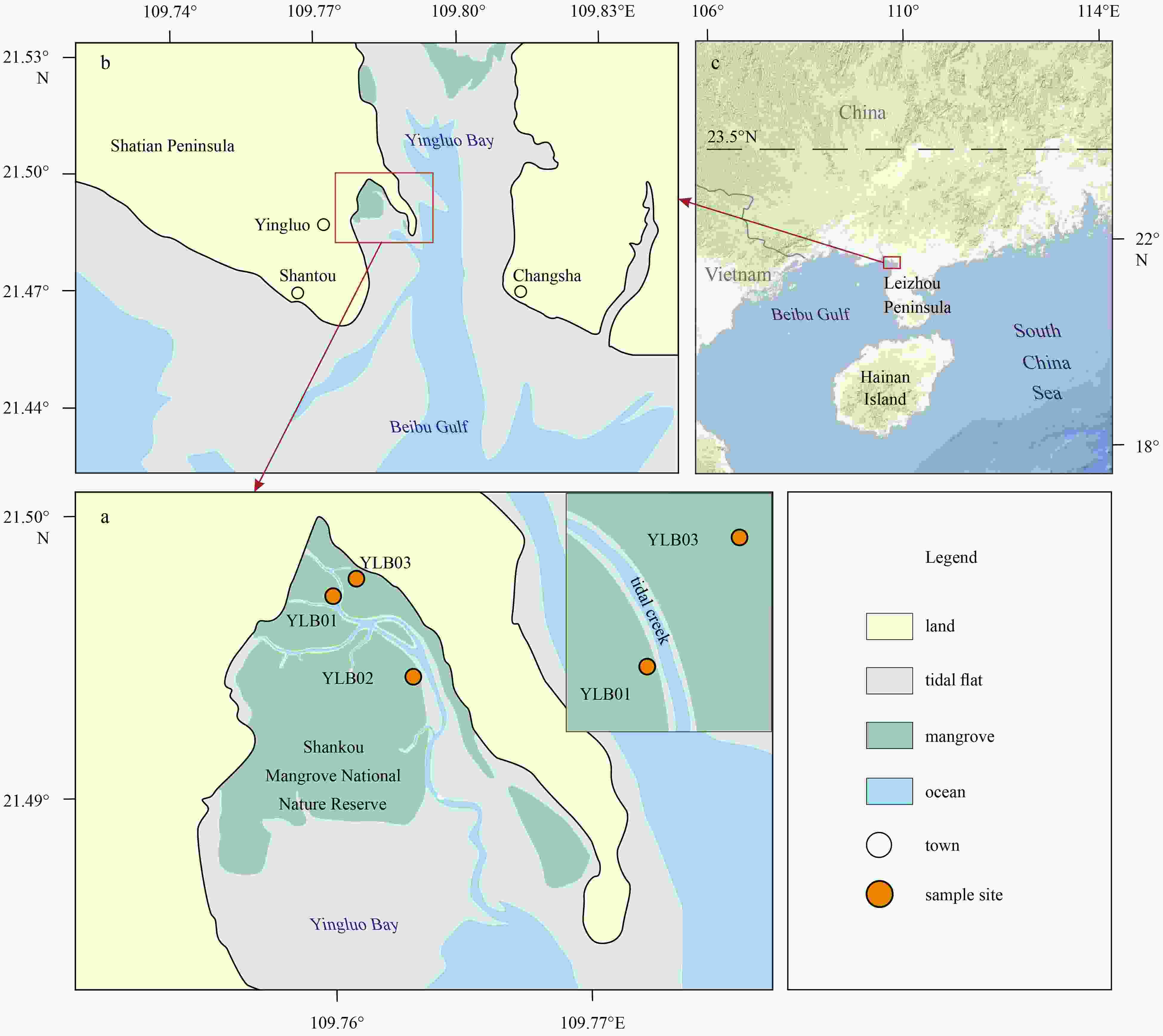
 下载:
下载:

